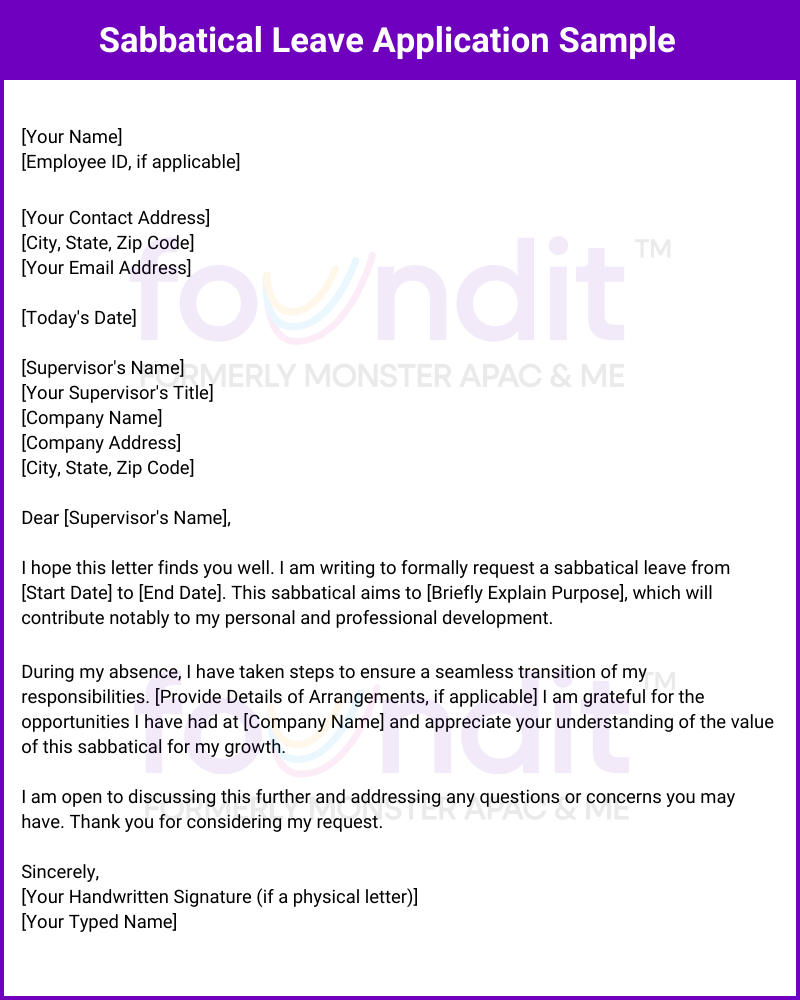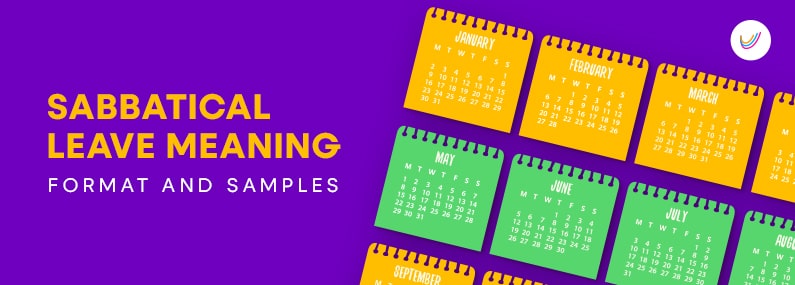Sabbatical leave meaning: a sabbatical leave is an extended break from work granted to an employee. It is different from annual or casual leave because your position remains secure while you are away.
Many employees use sabbatical leave for higher studies, research, travel, community service, or simply to recover from burnout. The exact rules depend on the company’s sabbatical leave policy, which may offer it as paid or unpaid leave.
What is a sabbatical leave? In simple terms, it is a planned leave of absence that supports personal growth or long-term goals. Companies introduce this option to retain talent, support professional development, and improve overall employee well-being.
This article covers the complete sabbatical leave definition, eligibility conditions, and policy features. You will also find a ready-to-use sabbatical leave application format and practical letter samples to help you apply with confidence.
Related: How to Write a Leave Application for Office [Format, Samples]
Sabbatical Leave Meaning & Definition
The term sabbatical leave comes from the idea of taking time off to rest or pursue learning. In the workplace, it refers to a longer break from duties that still protects your employment. Unlike a resignation, sabbatical leave ensures you return to the same or an equivalent role after your absence.
Sabbatical leave definition: an extended leave of absence approved by the employer, either paid or unpaid, that allows employees to focus on personal or professional goals. The duration may range from a few weeks to several months, depending on company policy.
This type of leave is different from casual, sick, or annual leave. It is planned in advance, comes with eligibility conditions, and is often linked to years of service. Many organisations include it in their sabbatical leave policy as part of employee benefits.
Here’s a simple comparison to understand how sabbatical leave stands apart from other leave types:
| Type of Leave | Duration | Job Security | Purpose |
|---|---|---|---|
| Sabbatical Leave | Months to a year (depending on policy) | Yes, position reserved | Education, projects, travel, family, recovery |
| Annual Leave | Few days to weeks | Yes | Rest, personal tasks, short travel |
| Unpaid Leave | Short to medium duration | Varies by employer | Personal reasons not covered under policy |
In short, sabbatical leave is a structured break that supports both personal development and long-term employee retention. Companies that provide this option often see improved loyalty and productivity when employees return refreshed and motivated.
Also Read:
| One Day Leave Application for Office | 3 Days Leave Application for Office |
| 2 Days Leave Application for Office | 4 Days Leave Application for Office |
Why Do Employees Take Sabbatical Leave?
Employees request sabbatical leave for many different reasons. Some use it for career growth, while others see it as a much-needed pause for personal commitments. Unlike short leave types, sabbaticals are usually planned months in advance and require clear communication with the employer.
One of the most common reasons is higher education. Professionals may take a break to complete a master’s degree, attend specialised training, or engage in research. In such cases, a sabbatical leave policy becomes an enabler for skill development without losing job security.
Another reason is personal well-being. Long stretches of work often lead to fatigue and burnout. A structured break helps employees return refreshed, which benefits both the individual and the company. Some also use the time to pursue hobbies, travel, or spend extended time with family.
Here are some of the most common situations when employees apply for sabbatical leave:
- Pursuing higher education or professional certification
- Conducting research or writing a thesis
- Personal or family care responsibilities
- Health recovery and mental well-being
- Volunteering, social work, or community service
- Travel or personal projects that require extended time
In short, employees opt for sabbatical leave when short-term leave is not enough. By offering this option, organisations demonstrate flexibility and trust, which often leads to stronger employee engagement and loyalty.
Related: Joining Letter Format and Samples
Sabbatical Leave Policy: Key Inclusions
A well-designed sabbatical leave policy ensures that both the organisation and the employee are aligned on expectations. Since sabbatical leave usually extends for months, clear rules help avoid confusion and make the process smooth for everyone involved.
Most companies treat sabbatical leave as a privilege rather than a guaranteed benefit. The eligibility and terms are set in advance and often linked to an employee’s years of service. While details differ across organisations, some elements are common to most policies.
Here are the usual inclusions in an employee sabbatical leave policy:
- Eligibility: Typically available to employees who have completed 3–5 years of continuous service.
- Duration: Can range from 3 months to 1 year, depending on role and company size.
- Paid vs Unpaid: Some organisations offer partial pay, while others mark it as unpaid leave but guarantee job security.
- Purpose of Leave: Should be stated clearly — e.g., education, research, personal projects, or family care.
- Application Process: Employees usually need to apply in writing, giving at least 2–3 months’ notice.
- Approval Authority: Final approval is typically given by HR and the reporting manager.
- Rejoining Terms: The policy may include conditions such as returning to the same role or serving a bond period after rejoining.
Some organisations also include additional clauses such as limiting the number of employees on sabbatical at a time, or requiring proof of enrolment if the leave is taken for higher studies. These measures ensure that business continuity is not affected while supporting employees fairly.
In summary, a clear sabbatical leave policy strikes a balance between employee growth and organisational stability. It gives staff the confidence to plan long-term goals while allowing employers to manage resources effectively.
Related: How to Write a Job Application Email
How to Write a Sabbatical Leave Application [Format]
Requesting a sabbatical leave requires a formal and well-structured application. Since the leave period is longer than usual, the letter must clearly mention the reason, duration, and assurance of returning to work. A clear application helps your manager and HR make faster decisions.
Here is a simple step-by-step format you can follow while writing a sabbatical leave letter:
- Date: Mention the date when you are submitting the application.
- Recipient’s Details: Add your manager’s or HR’s name and designation.
- Subject Line: Keep it clear, e.g., “Application for Sabbatical Leave.”
- Introduction: State your intention to request sabbatical leave.
- Reason for Leave: Briefly explain the purpose (education, family, research, etc.).
- Duration: Specify the start and end dates of your sabbatical.
- Assurance: Confirm your commitment to return after the leave period.
- Contact Details: Share how you can be reached during your absence.
- Closing: End with gratitude and request for approval.
Here’s a ready-to-use sabbatical leave application format you can adapt to your needs:
To,
[Manager’s/HR’s Name]
[Designation]
[Company Name]
Subject: Application for Sabbatical Leave
Dear [Manager’s Name],
I would like to formally request a sabbatical leave from [start date] to [end date]. The reason for this request is [state reason – e.g., pursuing higher education, personal commitments, or research].
I assure you that I will return to my role after the sabbatical period and continue to contribute effectively. During my absence, I am happy to support in handing over responsibilities to ensure a smooth transition.
Kindly consider my request and grant approval.
Sincerely,
[Your Full Name]
[Employee ID/Department]
Also Read:
| 5 Days Leave Application for Office | Annual Leave Application Letter |
| 10 Days Leave Application for Office | Forced to forgo an optional leave? |
Sabbatical Leave Letter Samples
Once you know the sabbatical leave format, writing the actual letter becomes easier. Below are a few sample letters for different scenarios. You can adapt them depending on your purpose and company guidelines.
1. Sabbatical Leave Letter for Higher Education
Subject: Application for Sabbatical Leave for Higher Education
Dear [Manager’s Name],
I am writing to request a sabbatical leave from [start date] to [end date] in order to pursue my postgraduate studies in [course/program name]. This opportunity will help me enhance my skills and contribute more effectively upon my return.
I am committed to completing the handover process and ensuring a smooth transition before my departure. I kindly request your approval.
Sincerely,
[Your Full Name]
[Employee ID/Department]
2. Sabbatical Leave Letter for Family Reasons
Subject: Application for Sabbatical Leave for Family Responsibilities
Dear [Manager’s Name],
I would like to apply for a sabbatical leave starting from [start date] to [end date] to attend to urgent family responsibilities. I assure you that I will return to my duties after this period and continue contributing effectively.
I am willing to provide support in handing over my tasks before my leave begins. I request your approval for the same.
Sincerely,
[Your Full Name]
[Employee ID/Department]
3. Sabbatical Leave Letter for Health Recovery
Subject: Application for Sabbatical Leave for Health Reasons
Dear [Manager’s Name],
I would like to request a sabbatical leave from [start date] to [end date] due to medical reasons that require extended treatment and rest. I have attached the necessary medical documents for your reference.
I will ensure that all ongoing tasks are handed over before my leave begins. I kindly seek your approval for this request.
Sincerely,
[Your Full Name]
[Employee ID/Department]
These sabbatical leave samples cover common situations faced by employees. You can edit the dates, reason, and details to make them suitable for your own case.
Here is another sample sabbatical leave letter for your reference :

Pros and Cons of Sabbatical Leave
Like any workplace policy, sabbatical leave has both advantages and drawbacks. For employees, it can be life-changing, but for organisations, it requires planning and flexibility. Understanding both sides will help you decide whether taking or offering sabbatical leave makes sense.
Here is a simple overview of the pros and cons of sabbatical leave:
| Pros | Cons |
|---|---|
| Gives employees time for higher studies, research, or personal projects | Extended absence may disrupt workflow or team balance |
| Helps reduce burnout and improve long-term productivity | Not all roles can easily be covered during long absences |
| Strengthens employee loyalty and retention | May be unpaid, leading to financial stress for employees |
| Improves employer branding as a people-friendly organisation | Needs careful workforce planning to avoid gaps in projects |
| Allows employees to return with new skills and fresh perspective | Some staff may struggle to re-adjust after a long break |
For employees, the key benefit is having uninterrupted time to focus on long-term goals while keeping their job secure. For companies, offering sabbatical leave can boost retention and create a positive work culture. The challenge lies in managing operations smoothly while staff are away.
Frequently Asked Questions on Sabbatical Leave
🔽 What is the difference between sabbatical leave and unpaid leave?
Sabbatical leave is a structured long-term break that ensures job security, often linked to years of service and HR policy. Unpaid leave, on the other hand, is usually short-term, granted for personal reasons, and may not guarantee the same role upon return.
🔽 Is sabbatical leave paid or unpaid?
It depends on the company’s sabbatical leave policy. In many organisations, sabbaticals are unpaid, though some offer partial salary, allowances, or benefit continuation for employees pursuing education or research.
🔽 How long can sabbatical leave last?
The duration varies from company to company. Typically, sabbatical leave lasts between three months to one year, though some employers extend it depending on role, industry, and employee needs.
🔽 Who is eligible for sabbatical leave?
Eligibility is usually based on years of service. Most policies require employees to complete at least 3–5 years with the organisation before applying for sabbatical leave. Senior or specialised roles are more likely to qualify.
🔽 Can I study during sabbatical leave?
Yes. Pursuing higher education is one of the most common reasons for sabbatical leave. Many organisations encourage it, as employees return with new skills and knowledge that benefit the company.
🔽 Do all companies offer sabbatical leave?
No, sabbatical leave is not a legal requirement. It depends entirely on the organisation. Larger companies and MNCs are more likely to include it in their HR policies, while smaller firms may not.
🔽 What happens if I don’t return after sabbatical leave?
If you fail to return, the organisation may treat it as a resignation. Some companies also include clauses such as repayment of benefits or restrictions on rejoining if terms are not followed.
🔽 How should I apply for sabbatical leave?
Submit a formal application or letter to your manager and HR. Clearly state the reason, duration, and assurance of returning to work. Providing sufficient notice (usually 2–3 months) improves the chances of approval.
Related Articles:




